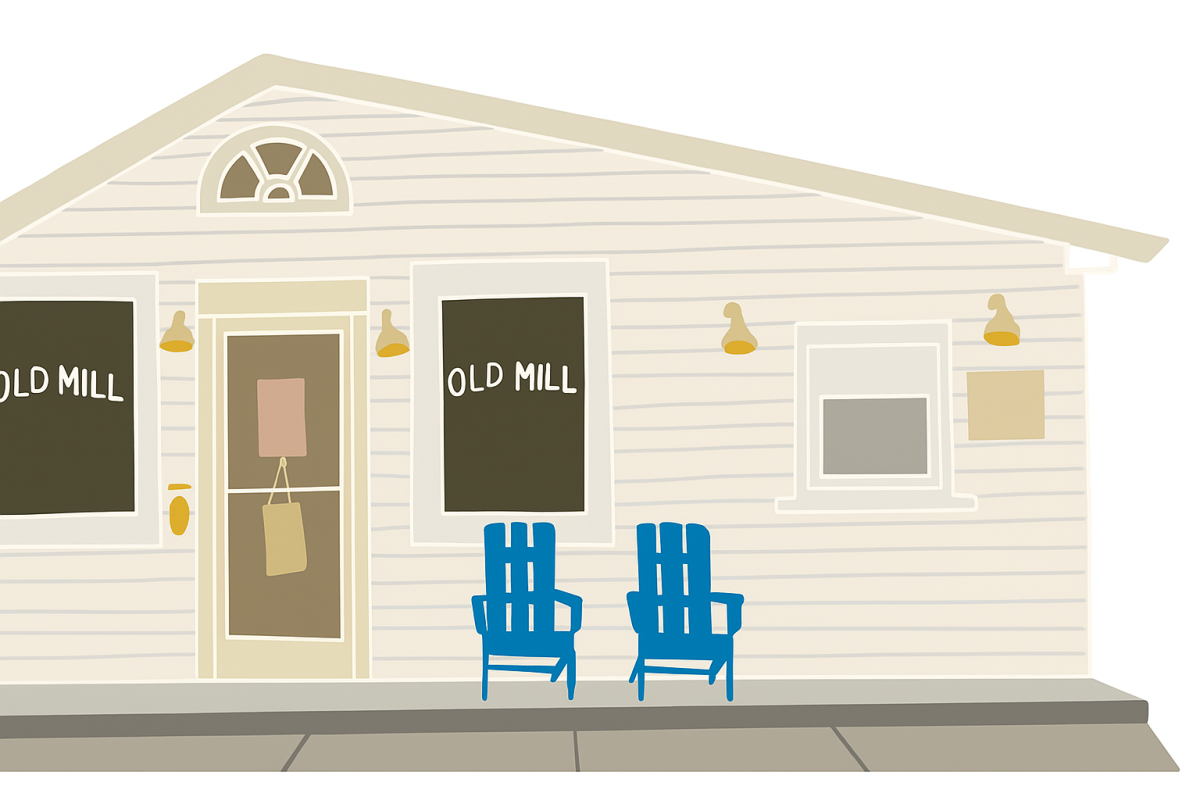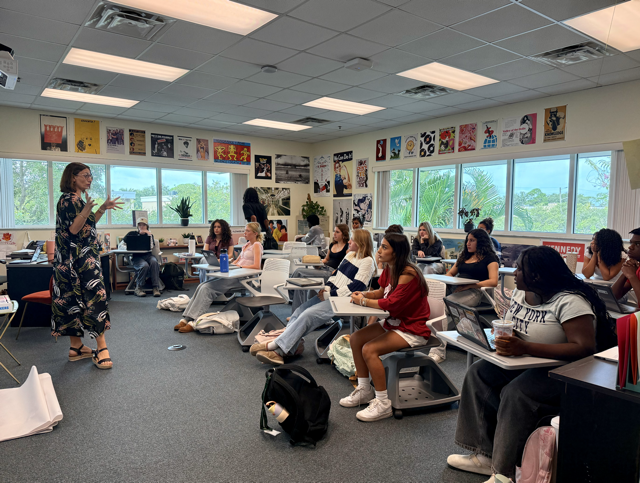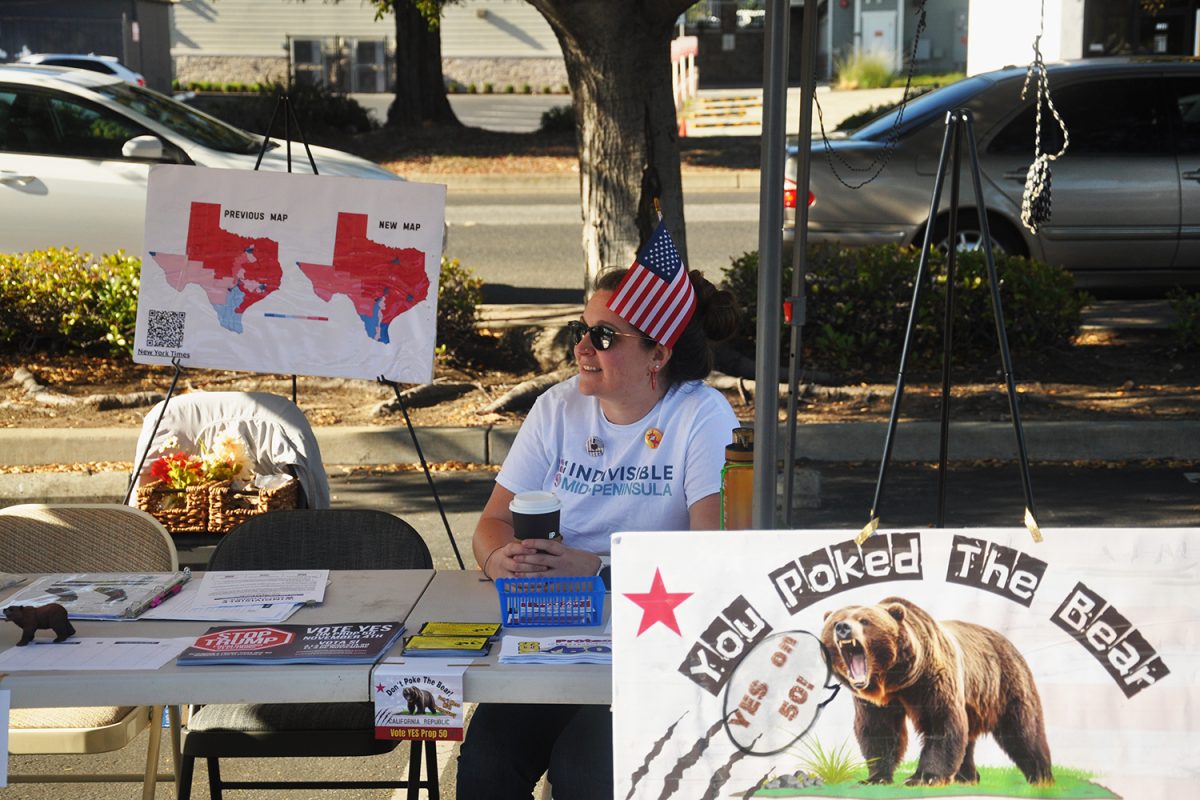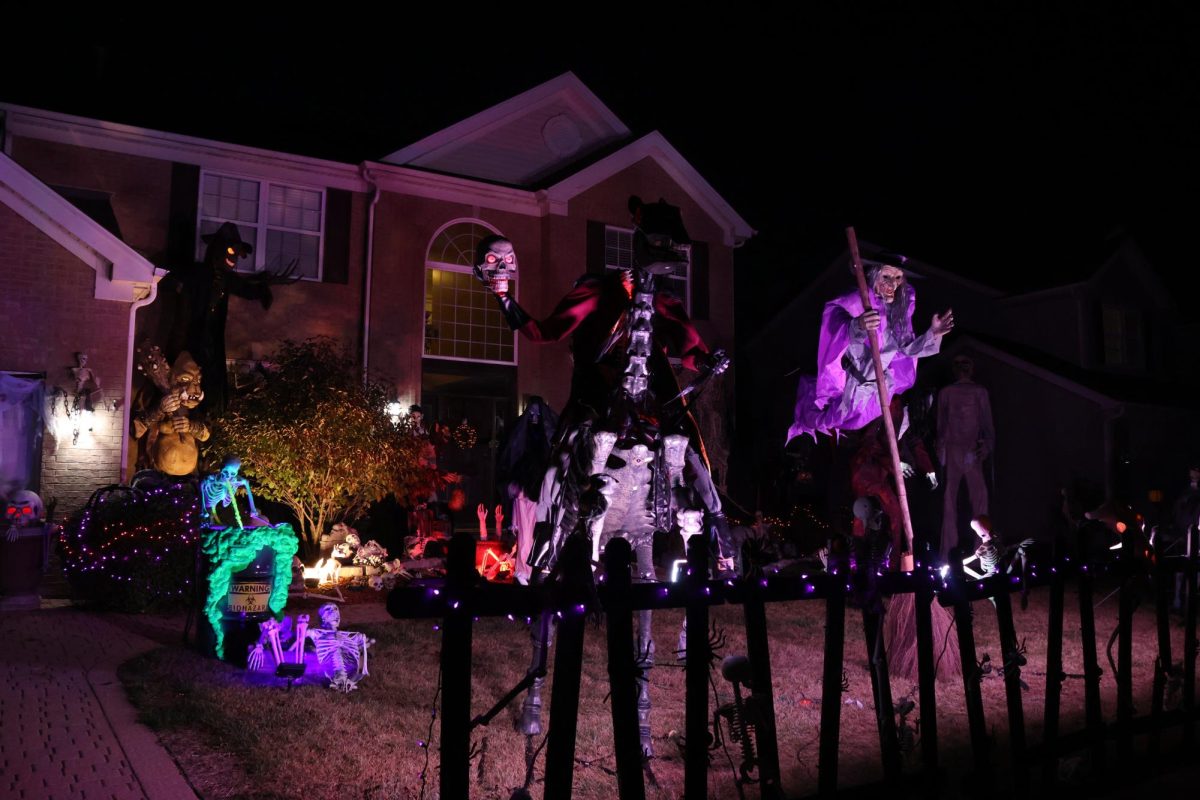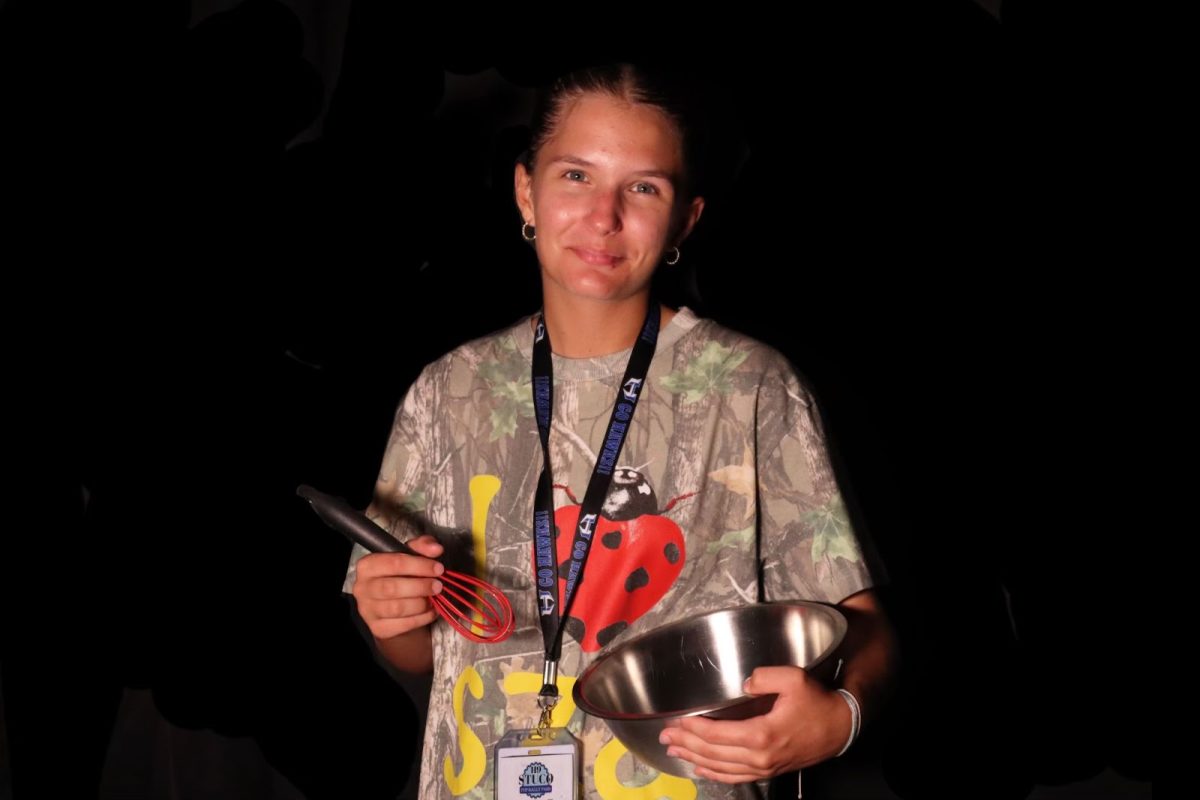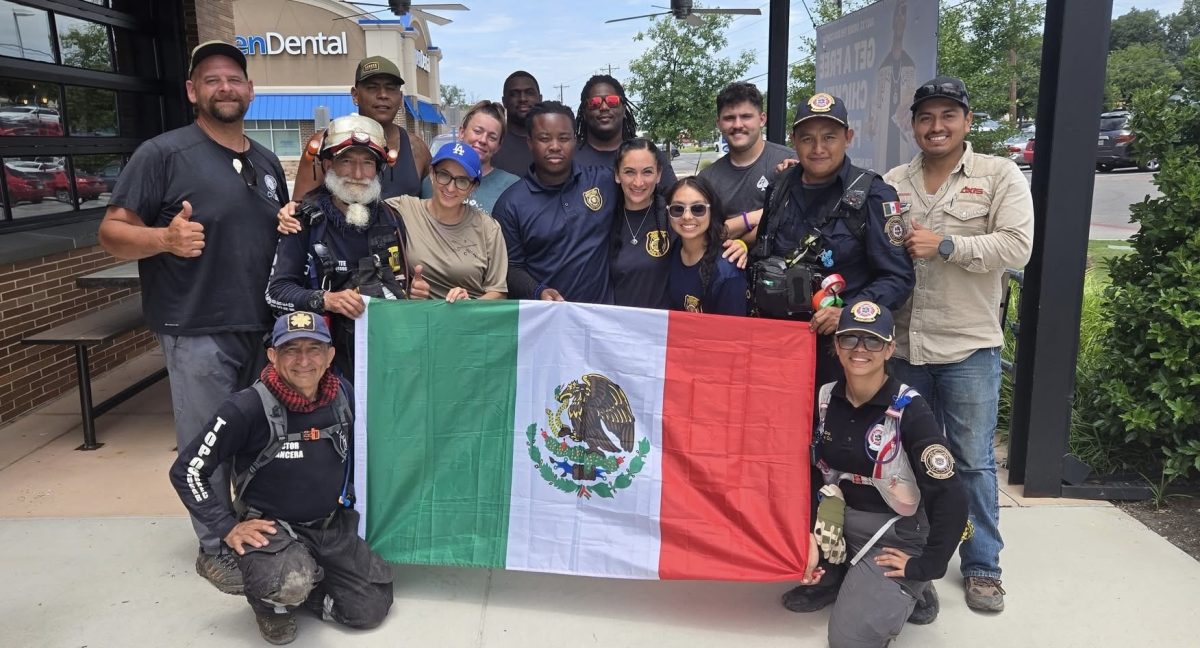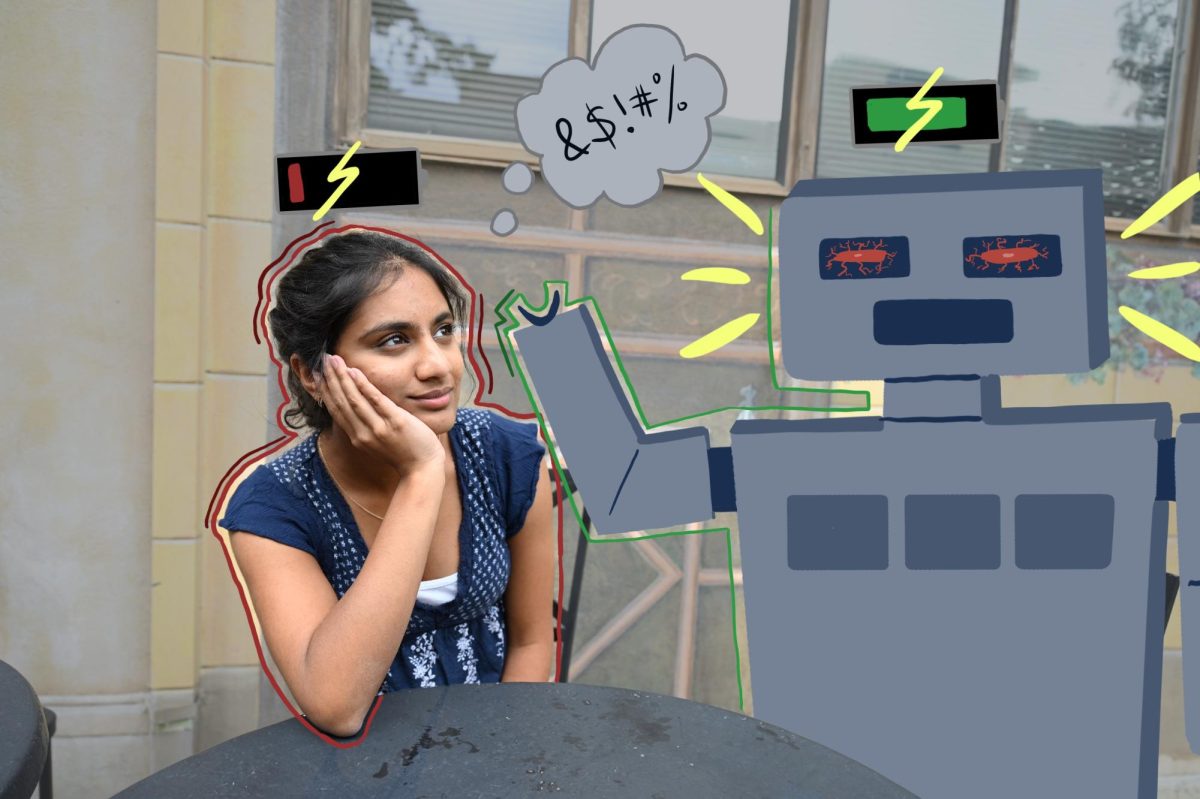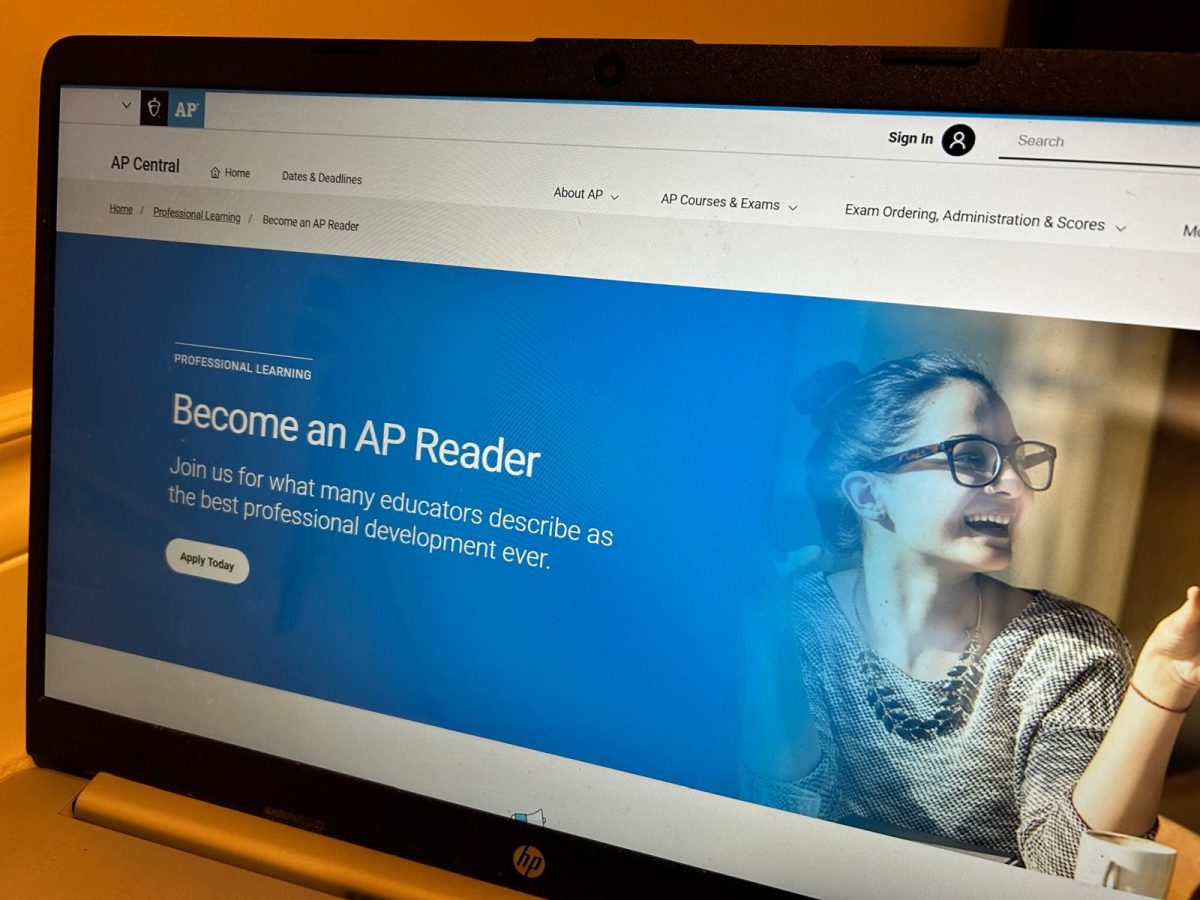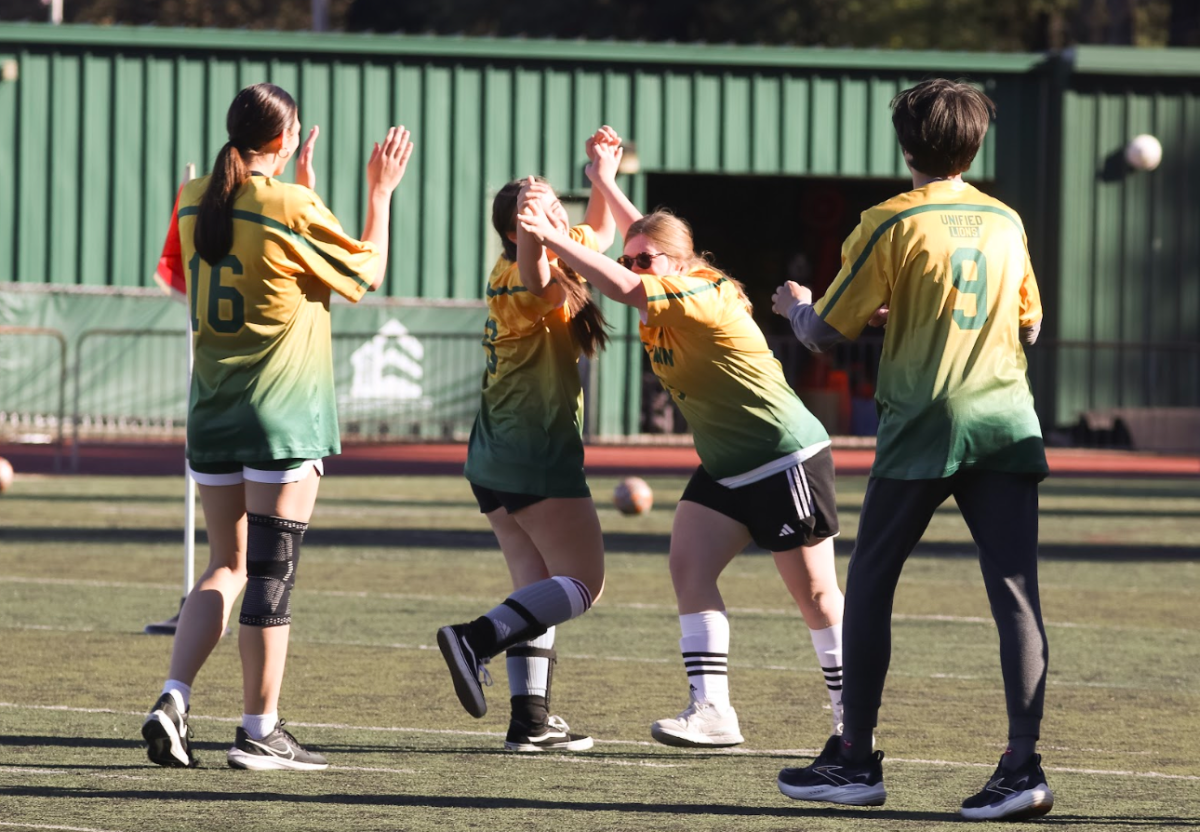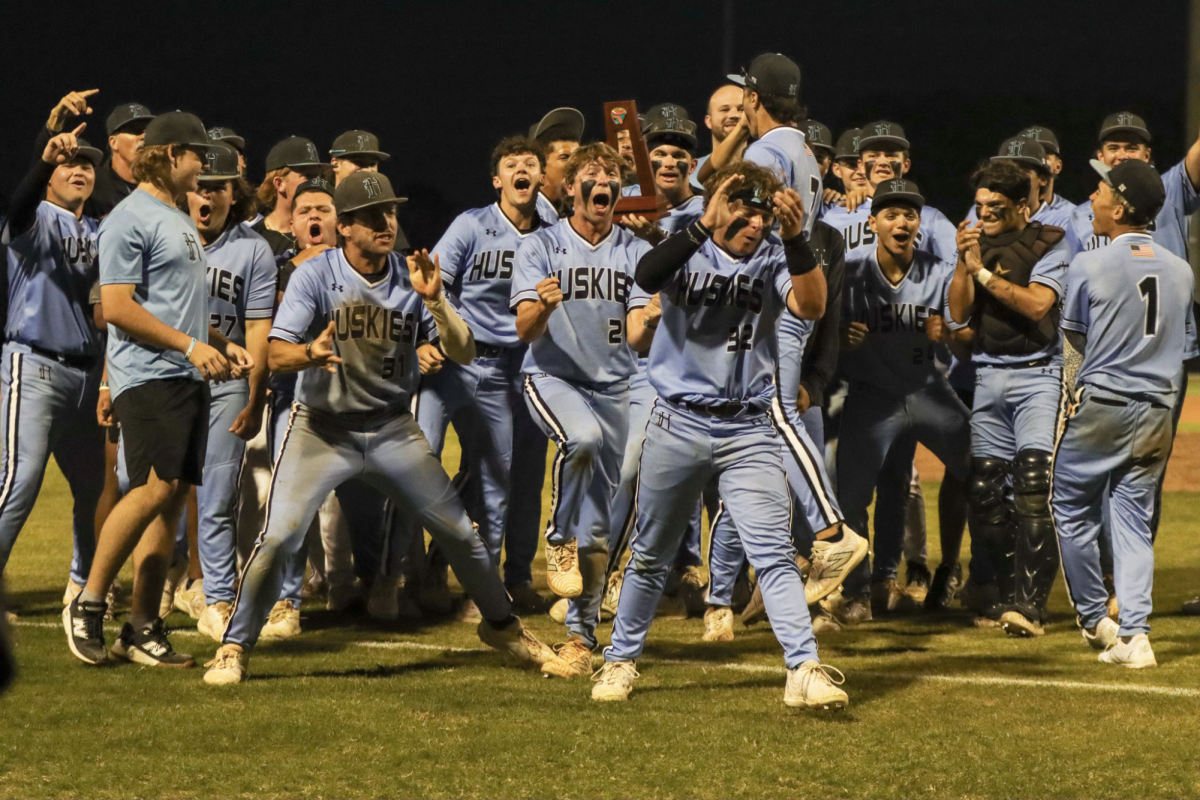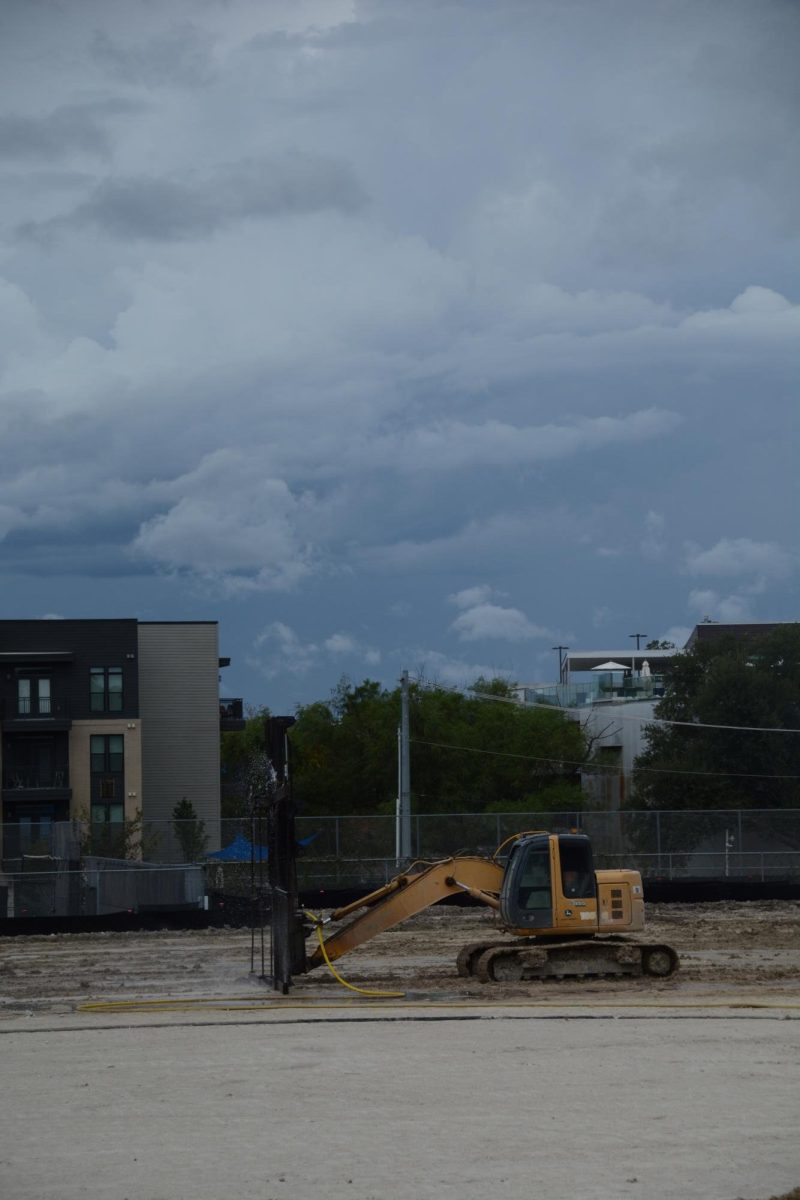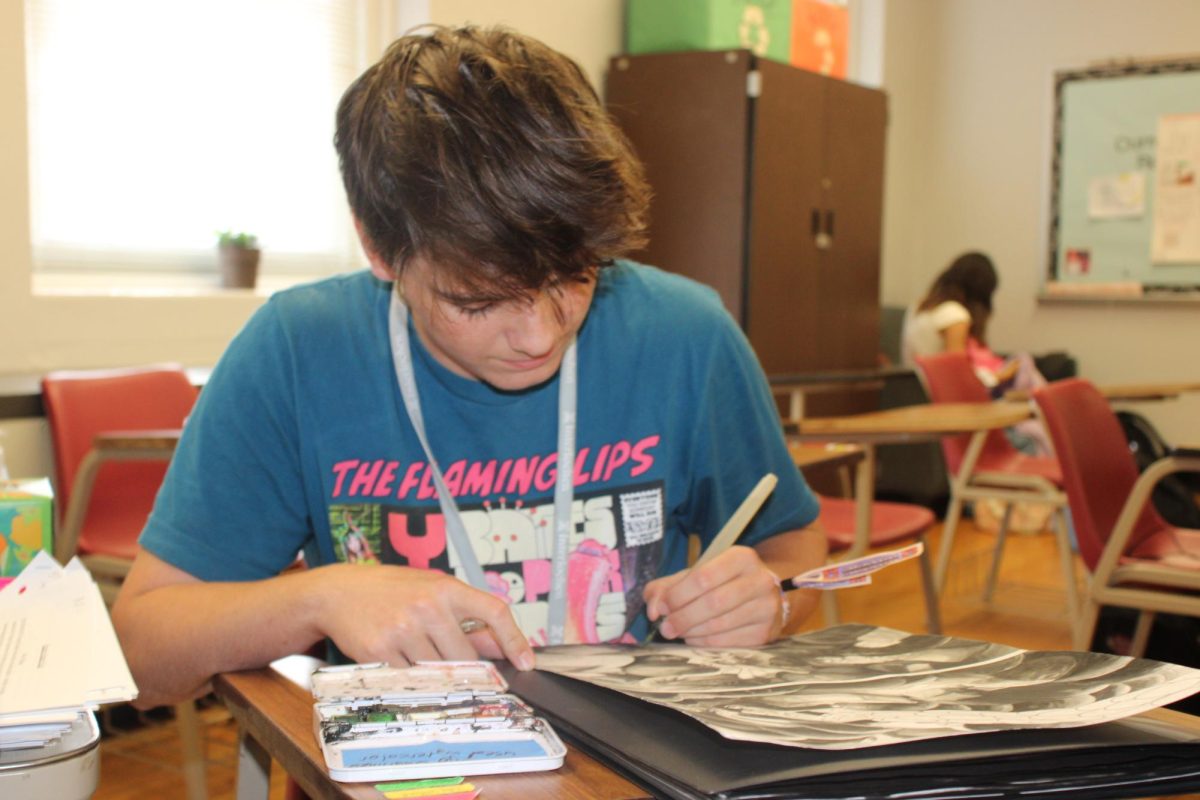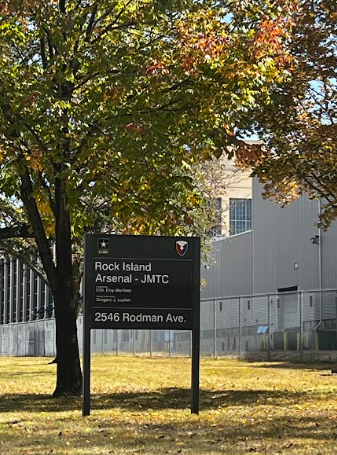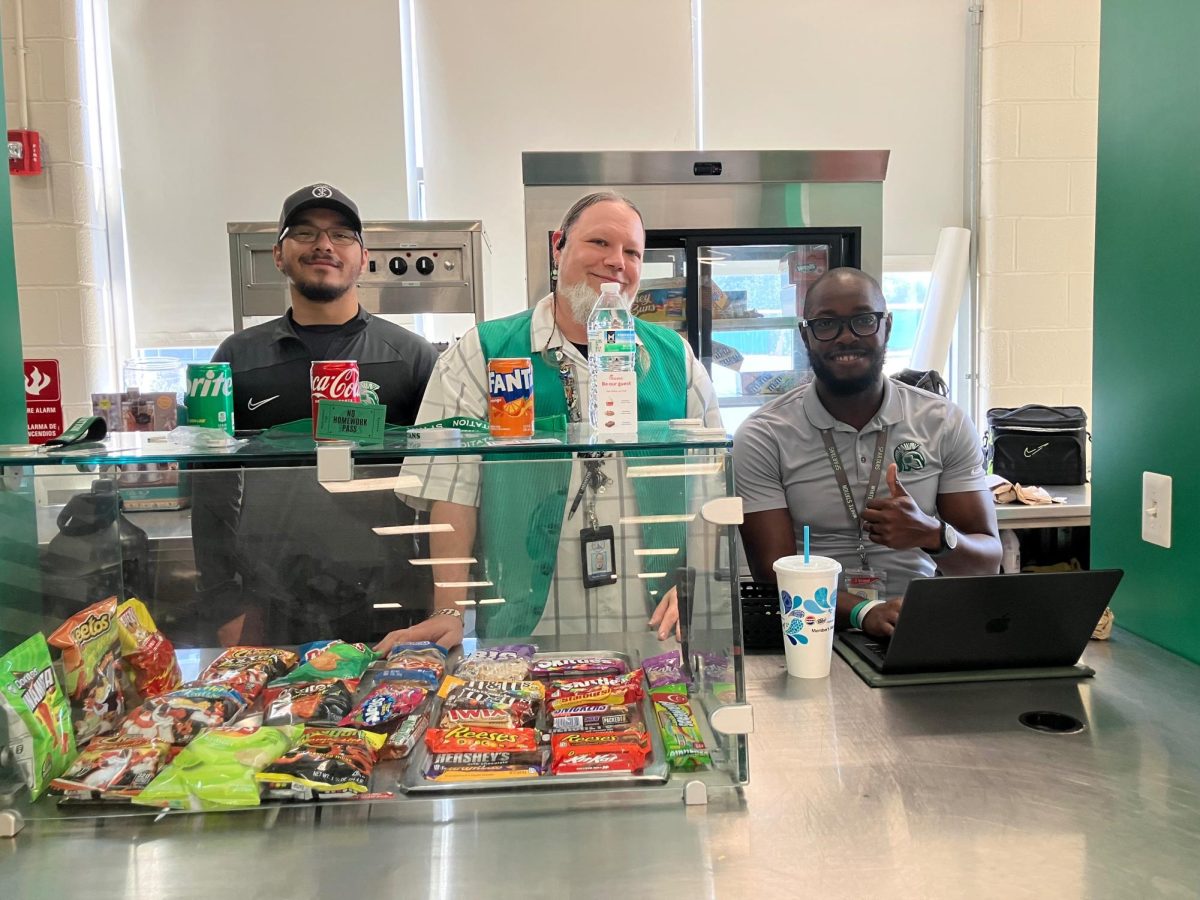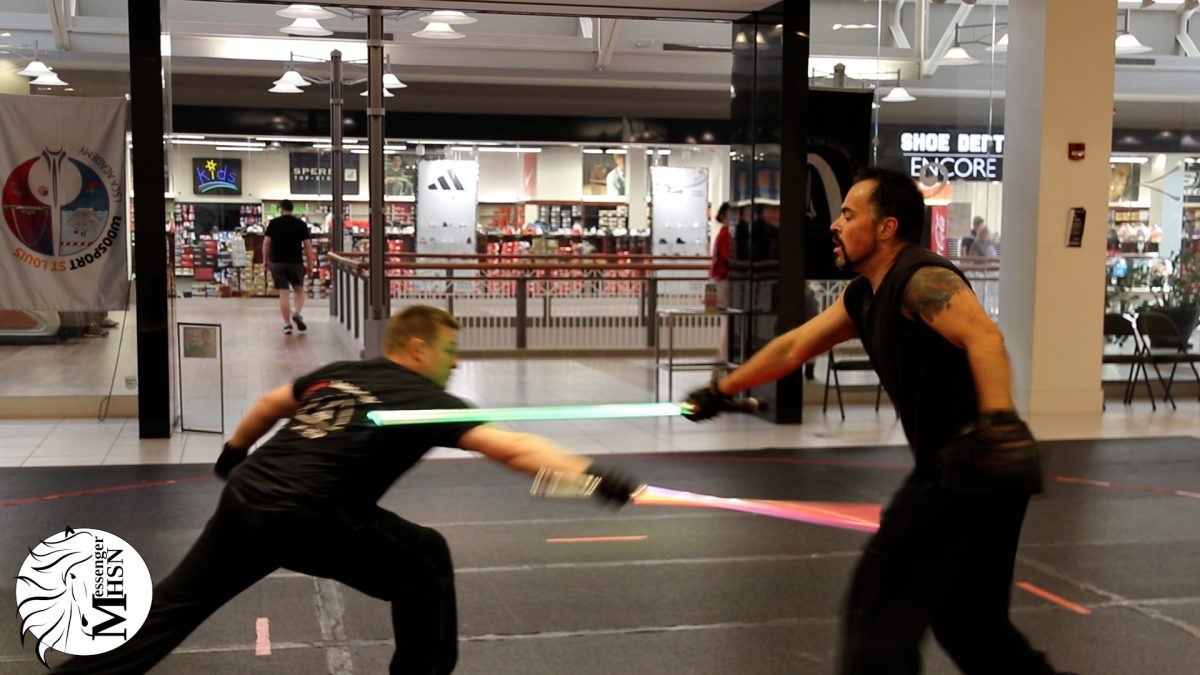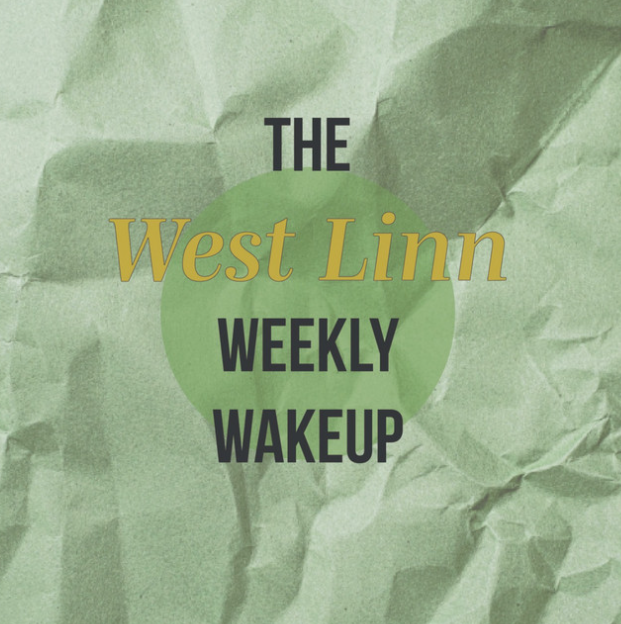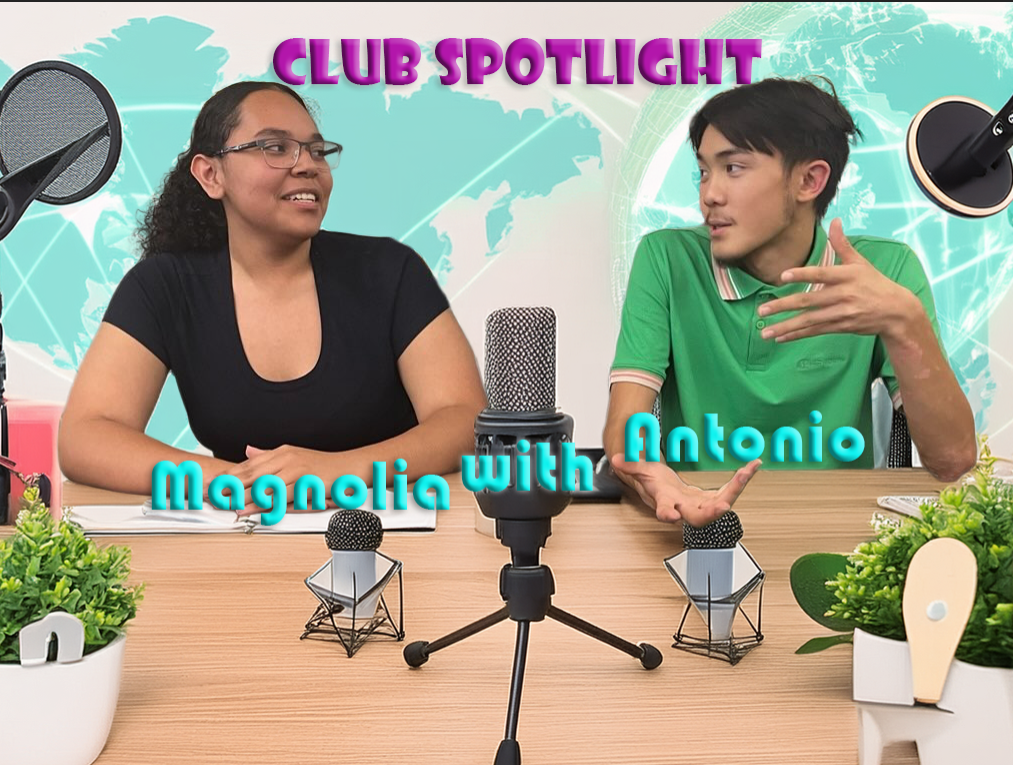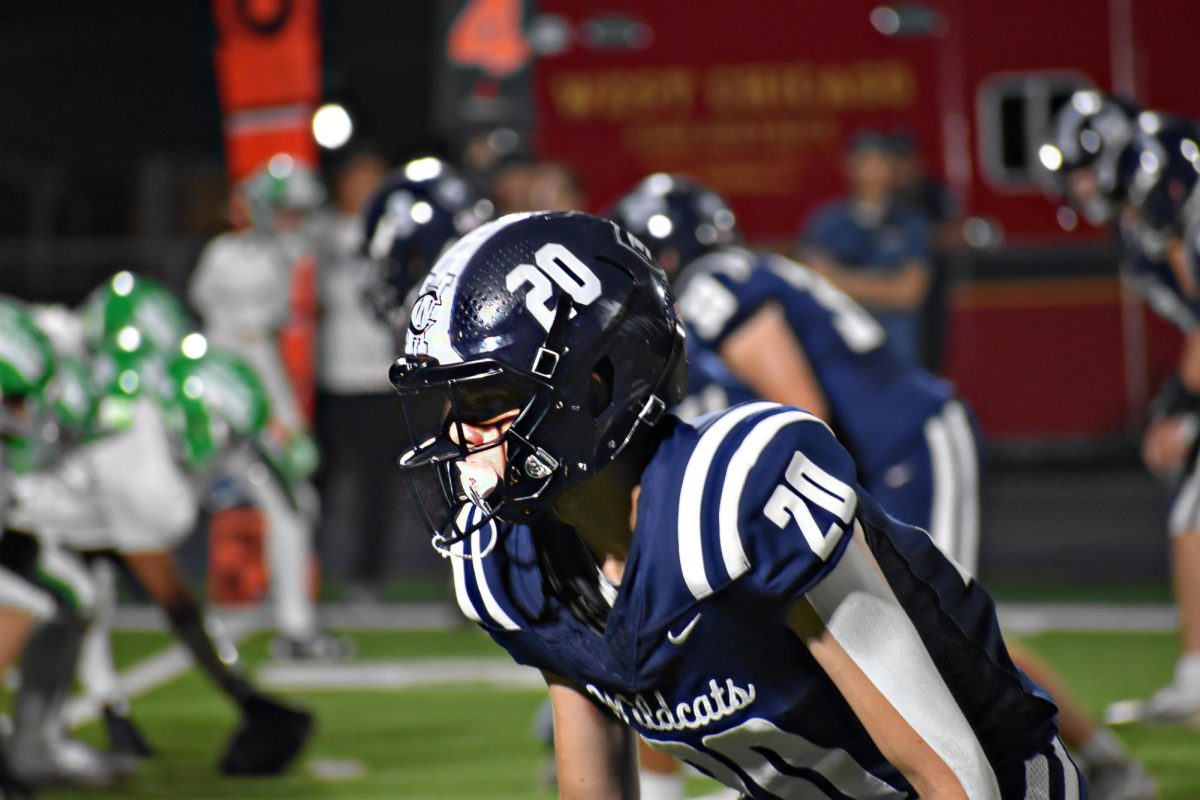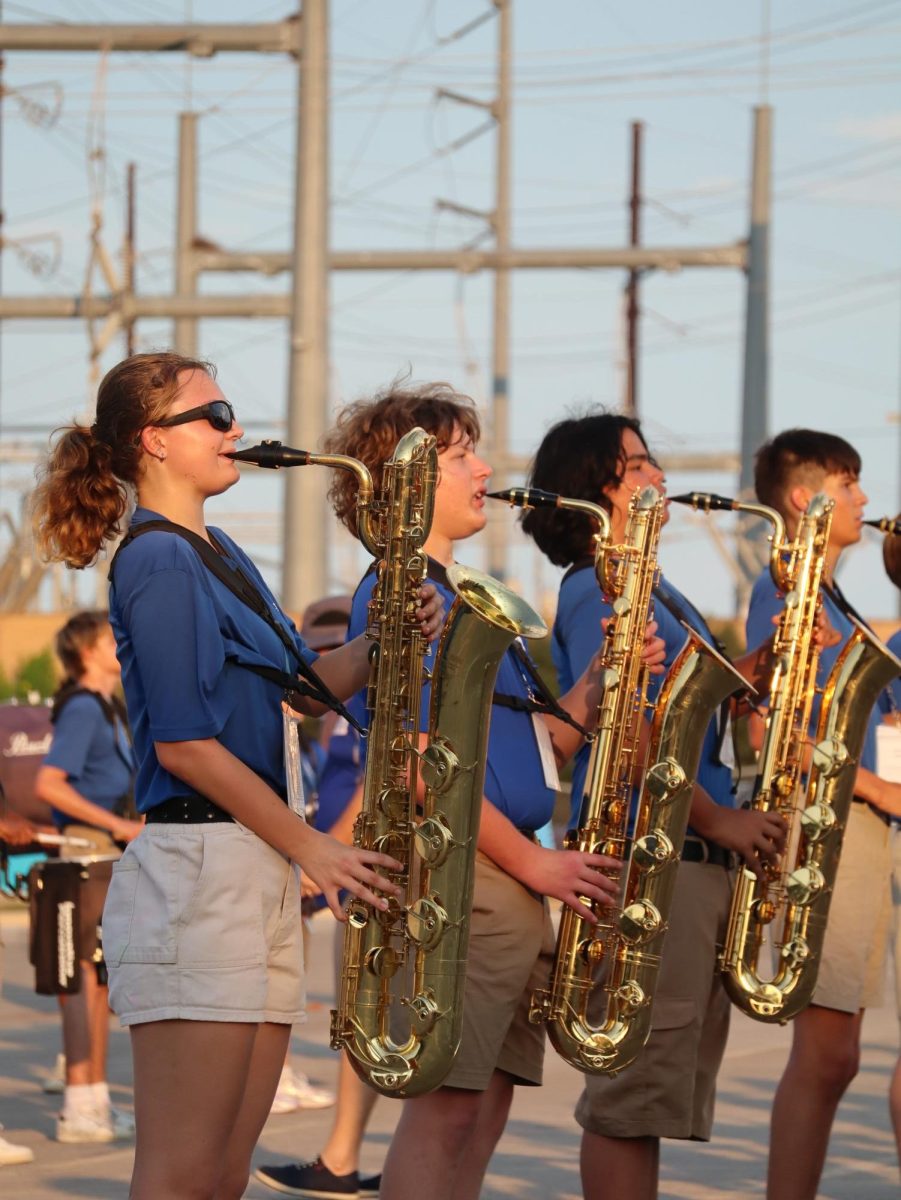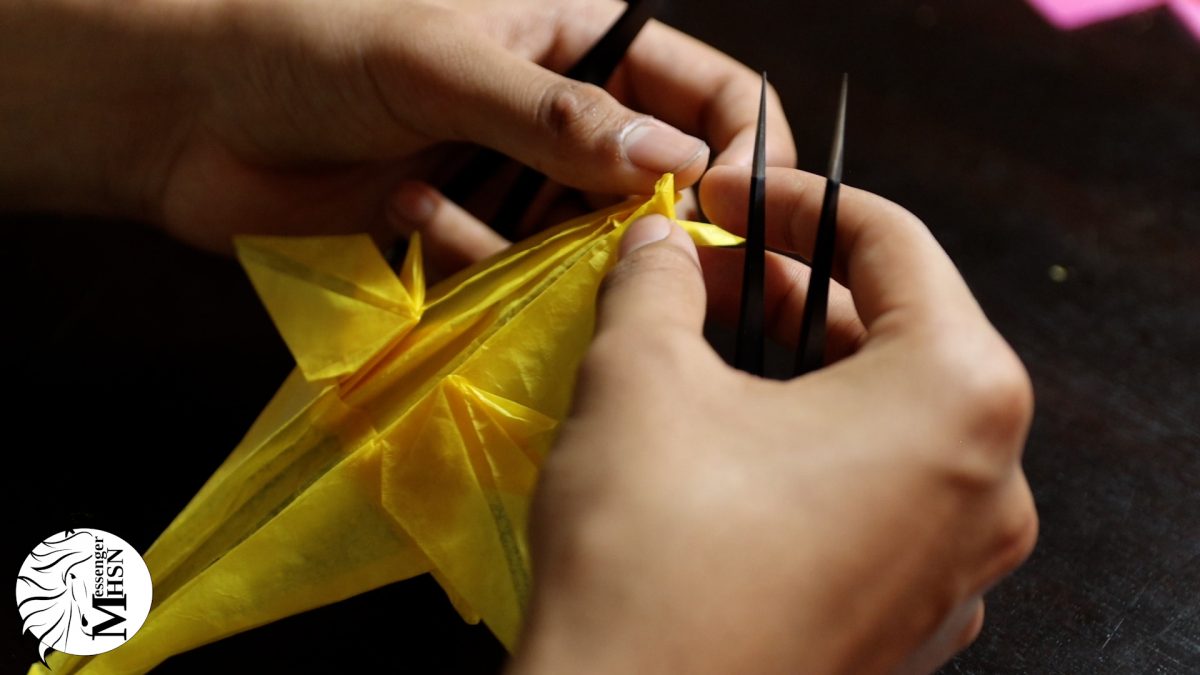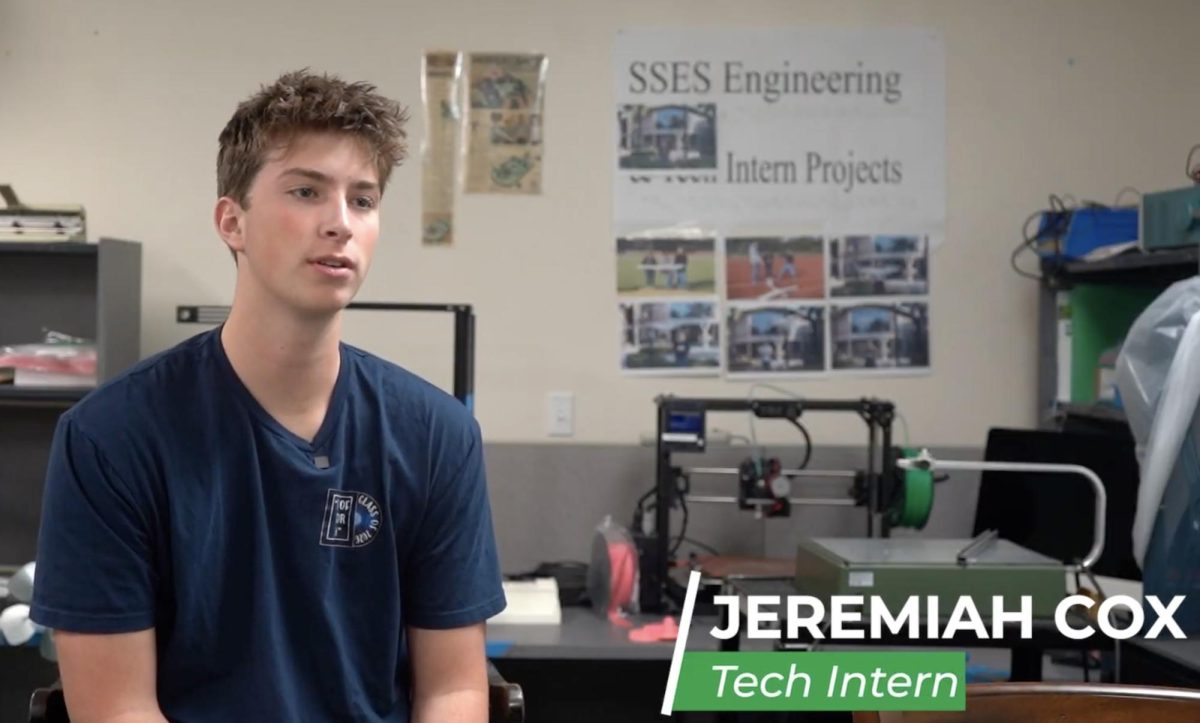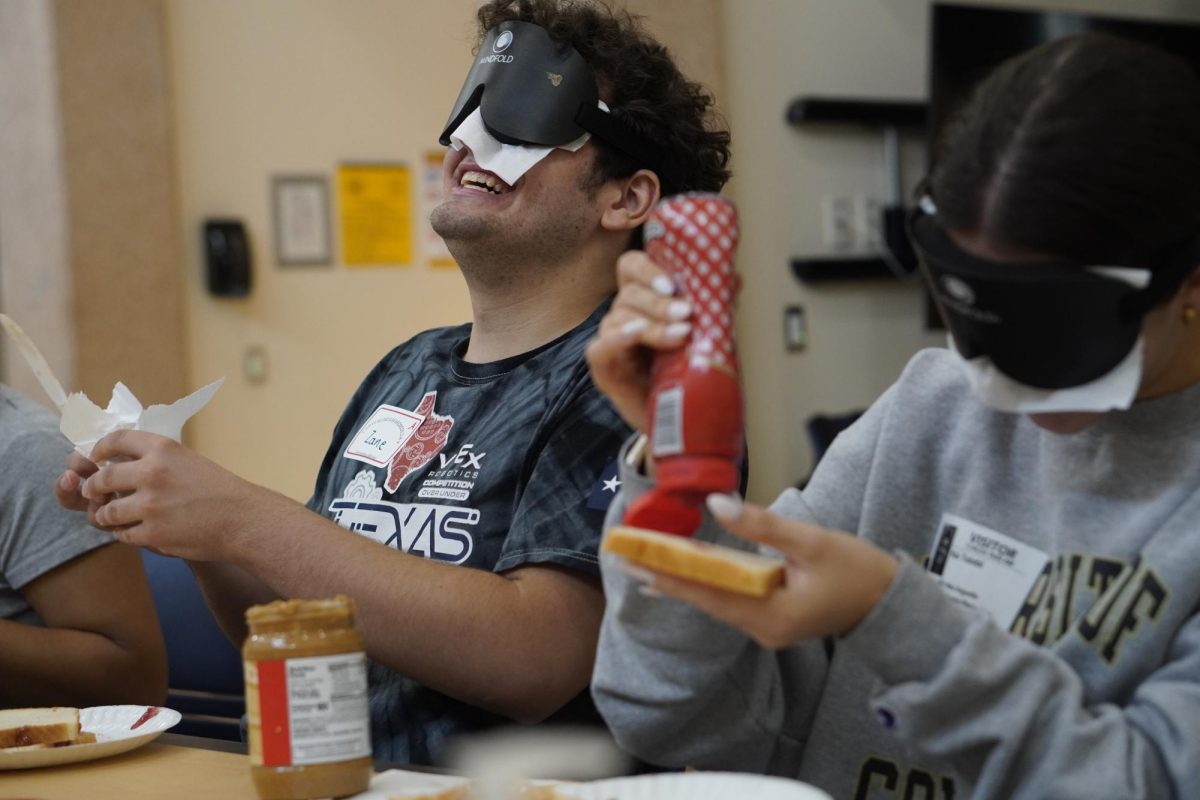Peer Assistance Leadership and Service students took a trip to the Texas School for the Blind and Visually Impaired last Tuesday for their annual Blind Awareness Day.
The event gave PALS members a chance to experience many tasks in a way to experience what it is like to be blind or visually impaired. The group rotated through stations, which included goalball—a game in which the ball has bells attached to it and teammates pass it around attempting to score in the opponent’s goal, as well as braille typing, sandwich making while blind, cane walking and learning about assistive technology for blind and visually impaired people.
PALS teacher, Richard Cowles has brought his students to this event for many years now. He said that the experience allows them to understand the differences between blind and sighted people but also the similarities and the humanity we all share.
Cowles said that the receptionist at TSBVI explained that although life is different for visually impaired people, it’s not depressing.
“He said, ‘My only concern about these Blind Awareness Days is that sometimes they leave here feeling sorry for us because they don’t have enough time to truly adapt. … People don’t recognize that we adapt, we are fine, we just live our lives a little differently … everyone has restrictions, ours is a little different, and we rely a little bit more on technology than some people do. We live our lives happily just like everybody else.'”

DIGITAL ASSISTANCE: Junior PAL Maya Tackett listens and watches an instructor at TSBVI demonstrate assistive technology to her group. One of the stations the PALS rotated through was about how audio and technology can help people with visual impairments, especially features on personal cell phones. Tackett enjoyed her first visit to TSBVI to learn about the technology.
“I wasn’t sure what to expect since I’m a new PAL, but Mr. Cowles went over the rough agenda, and I was excited,” she said. “My group started at the audio and technology station. I knew it was going over how our phones and devices are accessible to different kinds of people, but it was still so invigorating to see how much our phones could do. Our instructor was super funny and kept poking at us in a sarcastic way to get us involved, which I thought worked well.”
Along with the audio and technology station, Tackett enjoyed learning about the braille, and taking on the challenge of assembling a sandwich blindfolded, both giving her a new appreciation for her vision.
“One of my favorite stations was the braille typing which I didn’t expect to like as much as I did,” she said. “One of the student assistants, named Nathan, was giving me a one-on-one lesson which was super nice of him. It was also awesome to hear how braille helps him in his day-to-day life. I also loved making the sandwiches because it reminded me how even a seemingly everyday easy task, can be difficult. We also learned a lot of tips and tricks from the students at that station about what makes their experience.”
Visiting places like TSBVI has helped Tackett not take her sight for granted but realize that losing it can be manageable, thanks to new developments to help the visually impaired like the ones she saw in the audio and technology station.
“I think a lot of times I don’t realize how hard it can be for someone to be visually impaired, and how inaccessible our world is,” she said. “However, our visit demonstrated how things are slowly becoming more and more accessible for people. It’s important for anyone, not just the PALS, to go to places like this because it not only allows us to interact with different people than we usually do, but we also get to learn about how different people live their lives. I love learning about how different people go about their lives, so this overall was an amazing experience.”
Photo and caption by Wren Vanderford.
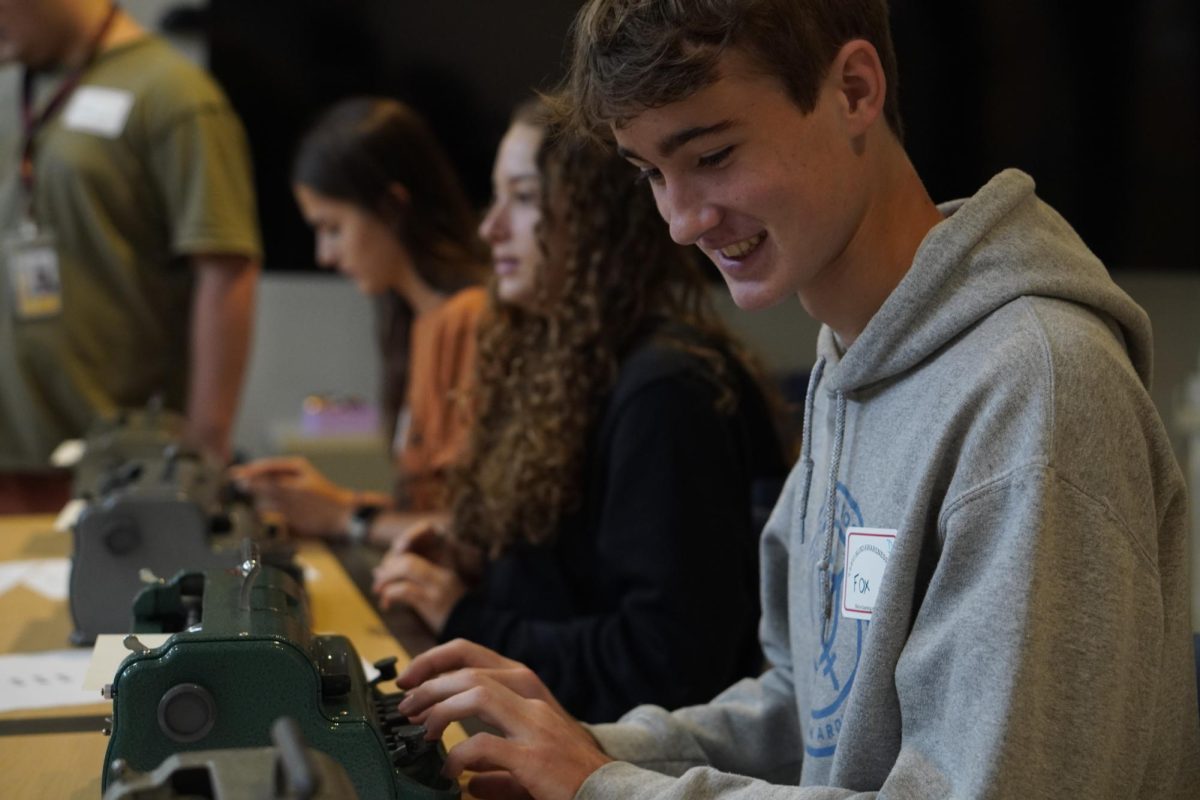
KEYS TO SUCCESS: Before his participation in the TSBVI BAD event, Senior Fox Redmond wasn’t familiar with braille, it history or how it works. At the braille station, Redmond was able to learn this skill with the help from a TSBVI teacher and student.
“I’ve never thought about how people who are blind type papers, and I thought it was really interesting to learn how the keyboard and the alphabet works,” he said. “It was only difficult because I had to use a key to remember which letter goes with each shape of braille, which was difficult but it’s pretty intuitive.”
Along with learning how to use a braille typewriter, Redmond also said that he enjoyed learning how to play the sport goalball and partaking in the other stations.
“It was a really fun day overall,” he said. “The awareness of how blind people and visually impaired people type and read was kind of my biggest takeaway.”
Photo and caption by Lillian Gray.
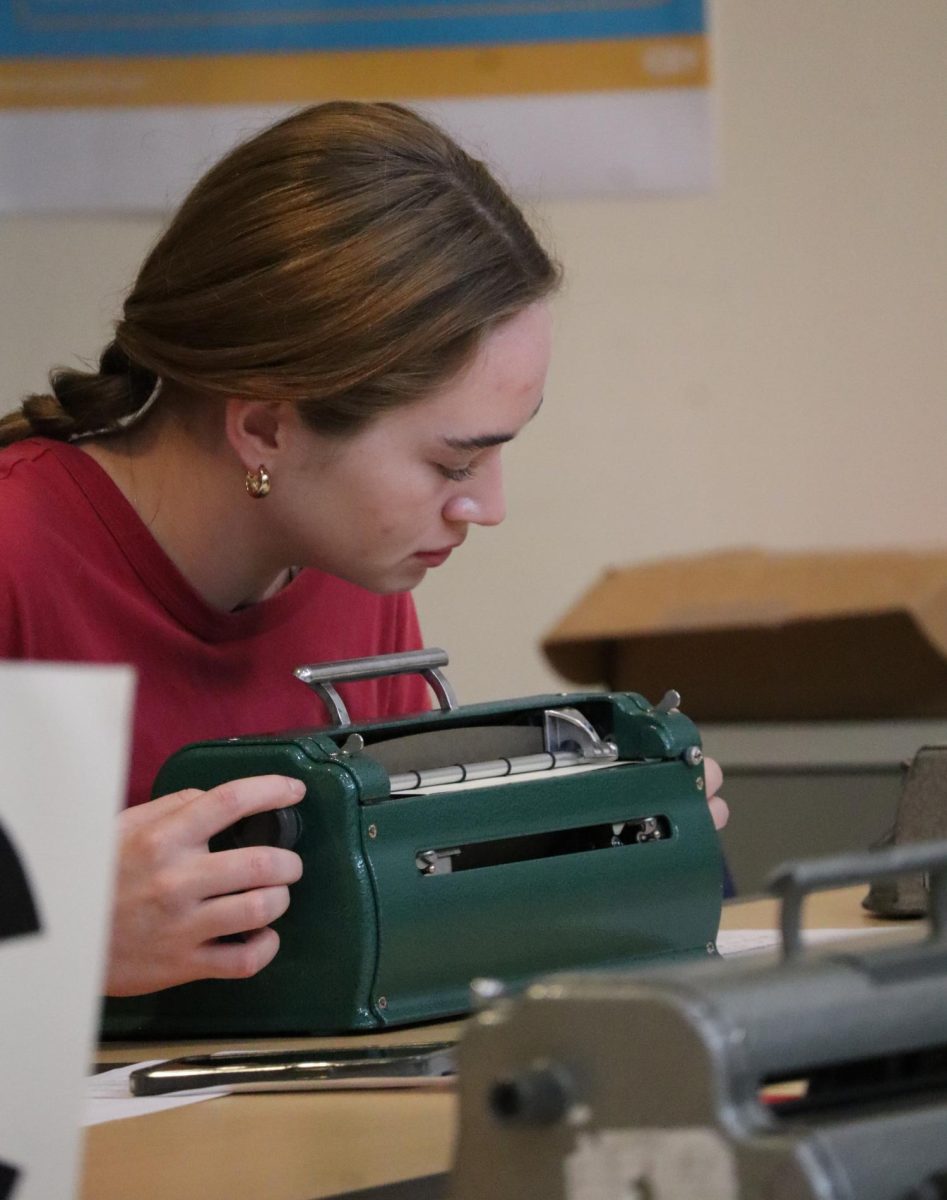
SEEING WITH TOUCH: Junior Imogen Hendricks investigates the braille machine. While at TSBVI, the PALS learned how to write braille, and the story behind how it became something visually impaired people could use to read and write. Hendricks had some previous experience visiting the school, but going with the PALS expanded her knowledge and understanding.
“I used to go to TSBVI with the Girl’s School of Austin every week, but we didn’t learn the full extent of braille as we did with this visit,” she said. “It was so fascinating learning all about it; it was originally meant to be used in the war by the French to type in code and now it’s evolved into something that visually impaired people can use to communicate through reading and writing.”
Although Hendricks did not have experience with braille going into the visit, she did have experience with music theory, and it helped her to overcome some challenges she encountered with learning the new language.
“It was a little hard to get the hang of it, but we had worksheets to help us,” she shared. “For me, it was a little more intuitive because it was also like reading music, similar to seeing a note or a number and being able to understand what it meant, so it helped to make a little more sense to me, but then I mostly got used to it. It was interesting because it was a completely different setup than how you would type on a normal keyboard, but it was fascinating to see how it works, how the students there actually do their homework every day and how they’re able to read and write”
She is thankful for all that she’s learned and for the chance to experience a new way of life alongside the teachers and instructors at TSBVI.
“The woman who was running that station was really lovely, and the student who was there assisting us, Nathan, was very sweet and understanding,” she said. “It was truly a highlight getting to learn braille and get a feeling of what their lives are like.”
Photo and caption by Wren Vanderford.
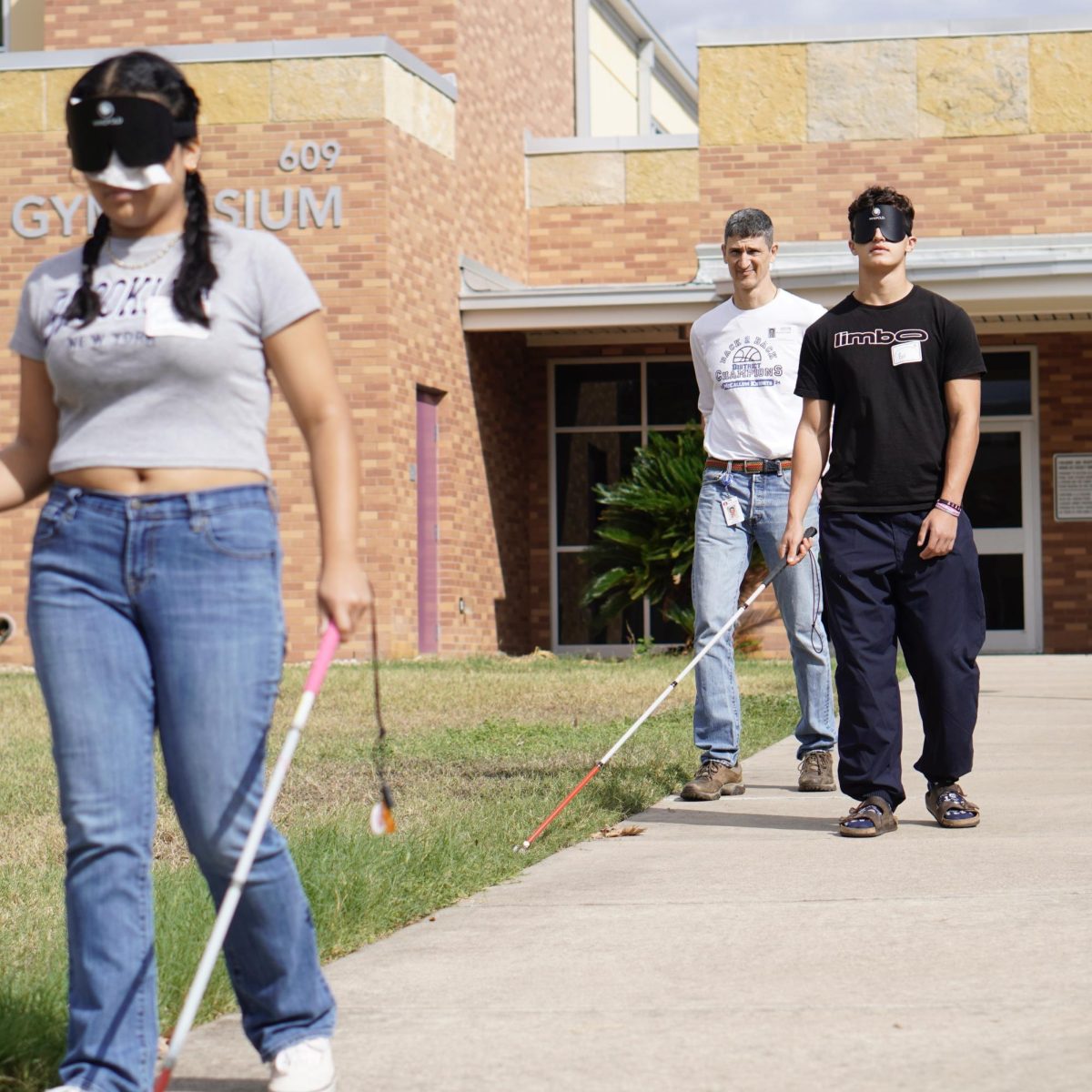
A CANE DO ATTITUDE: PALS teacher, Richard Cowles, walks beside senior Ben Martinez as he learns how to walk with a cane. Martinez and Cowles had come from the gymnasium behind them where they were able to do different tasks with a cane, learning to walk around, shoot a basketball blindfolded, drink water out of a water fountain blindfolded, and much more. Although Cowles did not use a cane at this year’s trip to TSBVI, for their Blind Awareness Day, he has in the past.
“It’s very overwhelming,” he said. “Being so tall I tip over easily so the whole balance thing was really hard for me. I’ve found a pretty good rhythm, eventually. The first time I did it it was very overwhelming, but the second time I did it I kind of knew what to expect. You do adjust.”
Cowles said that he hopes more people will understand others’ experiences and how they live their life, because it may allow for people to have more compassion, like he has found he has learned in some scenarios.
“Going to these events made me more aware,” he said. “One time I was driving past that awful intersection at North Loop and Burnet, it used to have that kind of weird right turn, and I was driving past, and I saw a guy with a cane knocking around trying to figure out that intersection, and he seemed so confused, so I immediately pulled over and got out and said, ‘Hey, this intersection is awful. Can I give you a tour?’ and he goes, ‘Oh my gosh, please, I have no idea what’s going on.’ I probably would have driven right past that if I hadn’t done things like this.”
Photo and caption by Lillian Gray.

BLIND BASKETS: Senior Tabatha Briceño prepares to shoot a basketball while blindfolded with the assistance of tapping from a TSBVI instructor. While learning how to walk with a cane, the PALS had the opportunity to do other small activities, such as jumping on a trampoline, boxing and even shooting baskets while blindfolded.
“At first when I used the cane, I was completely lost and felt a little bit overwhelmed because I was blindfolded,” she said. “It was hard for me to adjust at first but with some help from others, I felt a little bit better. As I was prepping to shoot the basketball, the instructor hit the cane on the backboard, so I could hear where to shoot the ball, and I found that that very helpful as I was able to use my other senses to help me.”
PALS had to use their canes to move around the gym, walk through the building to a water fountain and follow the paths outside back towards the recreational building. Walking with the cane was a new experience for Briceño and moving with it was something she had to adapt to.
“It was a lot more difficult than I anticipated because I had to remember how it was taught to us and the different motions,” she said. “It was my first time using the cane, and it helped me to understand what people have to go through with a disability. It was an awakening experience as it gave me a new perspective on the challenges faced every day by people who rely on canes for movement.”
Through the events at TSBVI, the PALS got to expand their horizons and learn more about the visually impaired, and Briceño was grateful for the experience.
“My biggest takeaway from volunteering is realizing that blindness doesn’t limit a person’s potential, it just changes the way they experience the world,” she said. “Overall, this experience shifted my perspective on this disability and helped deepen my empathy on how other people navigate the world in unique ways.”
Photo and caption by Wren Vanderford.

IN IT TO WIN IT: Although this was senior Cole Andersons first time playing goalball, he had come in prepared and ready to take on the challenge. Goalball is a sport where all players are blindfolded and throw a ball towards their opponents’ goal, aiming to make it in the goal and score. The ball is also filled with bells that allow players to hear where the ball is coming to try to attempt to block it. Anderson said that he realized the sport was unlike any other he’d played before, leading him to take time before he played to get ready for it.
“I was watching film beforehand,” he said. “I was watching the women’s Paralympics, the men’s Paralympics too, I was really trying to get into it, and it’s a really cool sport if you think about it.”
When the game started though, Anderson knew the general idea of the sport, but had to adjust to actually playing in it.
“I always felt like I was going to run into stuff, but you had the goal there, you had the tactile tape on the floor so you could kind of tell where you were, it was a pretty fun experience overall but it was kind of scary,” he said. “The biggest challenge was definitely having to try to find the ball without being able to see it. The bells kept throwing me off. I always thought it was closer than it was.”
Anderson had learned about the sport a few weeks before and hadn’t even heard about it before. He came away from the experience, feeling like more people should know about it, since for him it was a lot of fun. Along with getting to play the game, the TSBVI coach had a varsity goal ball player show the PALS the level that they play at there. Despite Anderson’s preparations, it made him understand how unprepared he actually was.
“They had the varsity student come in,” he said. “He was showing us how to throw the ball: it was eye opening. I just know any kid at that school would have wiped the floor with me.”
Photo and caption by Lillian Gray.
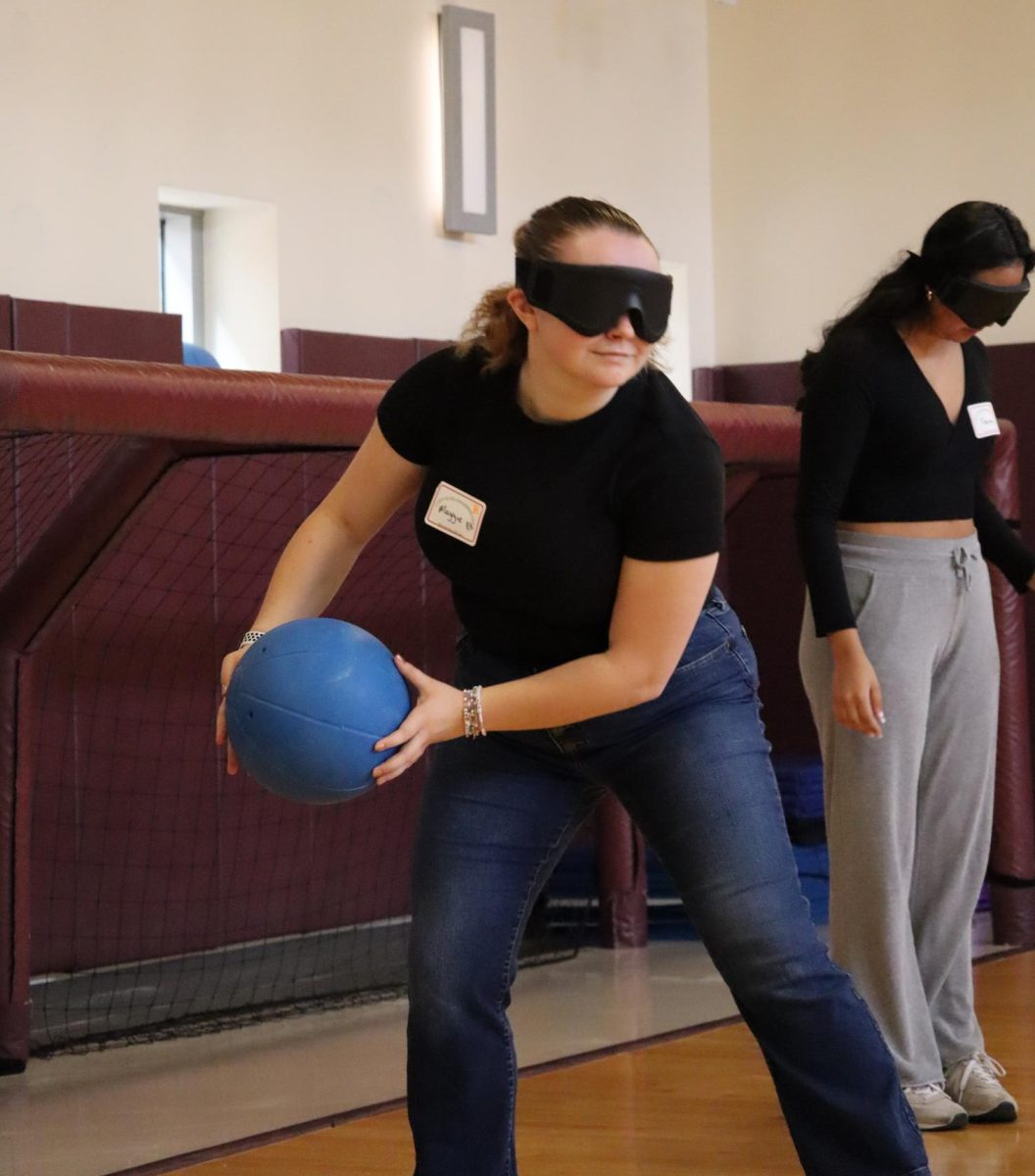
LISTEN FOR THE BALL: Junior Maggie Brown prepares to capture the ball during a game of goalball, predicting where the ball will end up. While in their groups, the PALS each got to try their hands at goalball while blindfolded. The ball contains two bells inside, and without their vision, the PALS had to intensively listen to grab the ball and throw it into the other team’s goal. Despite the difficulty of being blindfolded, Brown still enjoyed trying goalball and learning new techniques.
“Playing goalball was fun but challenging at the same time,” she said. “That day was my first time playing the sport, and it was pretty disorienting to be blindfolded, but it encouraged my team to be more communicative and use our other senses to make up for the lack of vision. It was also so cool to see the students who play goalball competitively since they were all so good at the game.”
According to Brown, the visit in its entirety was incredibly educational and enjoyable.
“The day was super fun and informative,” she said. “Every PAL had a great time because we were able to collaborate as a team while we tried new things. We also met some cool people who were all very invested in answering our questions and helping us better understand how blind and visually impaired people interact with the world. I’m so grateful for the opportunity to visit TSBVI and meet the awesome people who volunteered their time to teach the PALS,” Brown said. “It was such a great time and a really impactful event.”
Photo and caption by Wren Vanderford.

JUST HIS TYPE: At the braille station, Nathan Cox, who has been a student at TSBVI for four years, teaches Mac PALS how to use a braille typewriter. He, along with a TSBVI teacher, also talked about the history of braille and how it came to be and is now a very useful tool for people who are blind or visually impaired. For many of the PALS, this was their first time using a braille machine, which for Cox was fun since he got to teach them something new.
“Sometimes it’s hard to teach people how it works,” he said. “It’s important for them to know some braille just in case something out of the blue happened and they lost their vision, which most likely won’t happen. Also people are just curious about how it works.”
Cox has been learning braille for a while now and was able to use his expertise to explain the process to PALS.
“Since I already had experience with it, I thought teaching braille was very straightforward,” he said. “I was a kindergartener when I first started learning braille and dropped it for a long time, but got back to it and I’ve gotten pretty fluent. Even though people do make mistakes I respected that and moved on so people could improve.”
Along with his classes at TSBVI, Cox also takes astronomy at McCallum, similar to some of the TSBVI students there, who are also enrolled at Mac courses. Teaching Mac students braille also allowed him to connect with more students at the school.
“I liked getting to just teach people how braille works, and I thank everybody for coming here today,” he said.
Photo and caption by Lillian Gray.
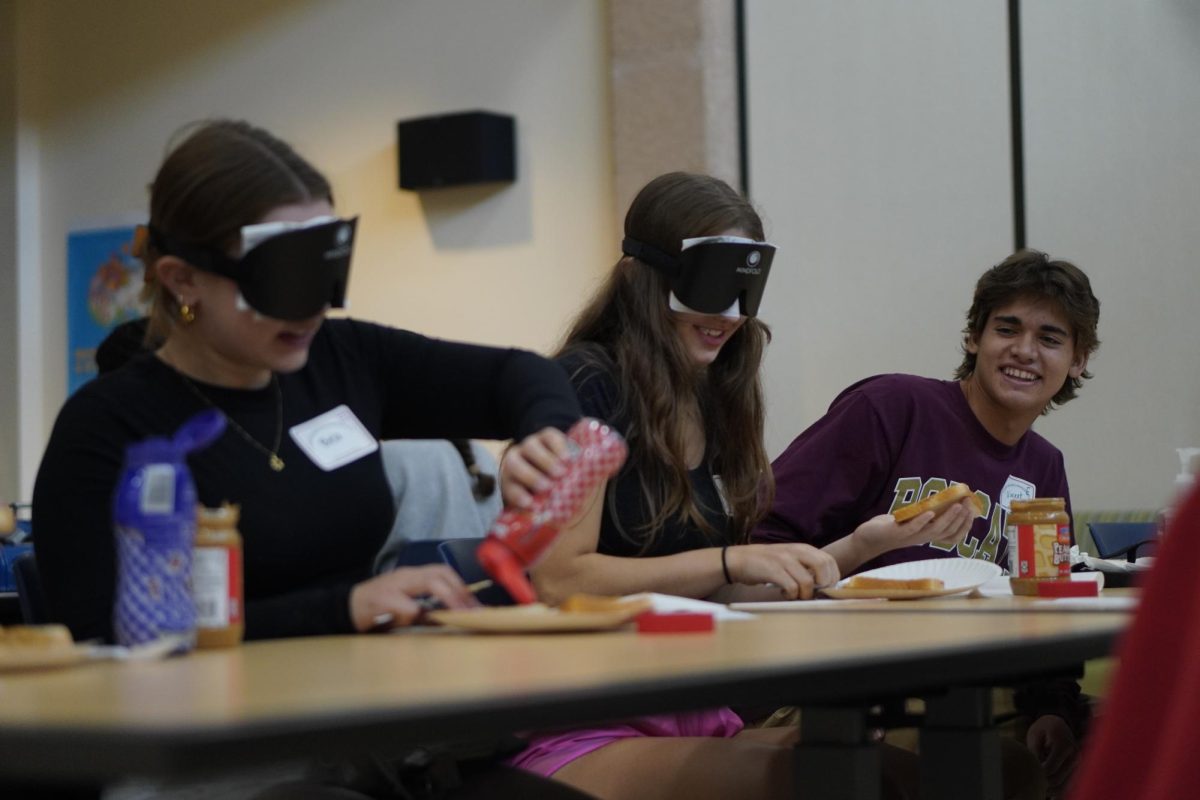
BLIND CULINARY ARTS: Senior PAL Bea Saffer laughs with her team members while trying to spread peanut butter on the bread of her sandwich. The PALS were given the challenge of making a peanut butter and jelly sandwich while blindfolded, working to put condiments on the bread, cut the bread properly and communicate with each other to share ingredients without vision. According to Saffer, a loss of vision made the task exceedingly difficult.
“Making the sandwiches went OK for me,” she said. “It was a lot harder than I expected, but I mainly struggled with the jelly. It was hard to tell how much you were putting on the sandwich without rubbing your hand in it, so I just sat there squeezing it, but there was nothing in my sandwich.”
Saffer also had a newfound appreciation for her vision, which gave her a new outlook on the importance of schools like TSBVI.
“I think I’m a lot more grateful for my vision because a lot of the activities that we were doing, even just walking down a hallway without sight, were so difficult, and it gave me a greater appreciation for my eyes,” she said. “It made me realize that people who have vision loss can lead relatively normal lives with training. One of the main lessons of that day was that without vision you struggle a little bit in the beginning, but once you adapt and with the help of places like TSBVI you can learn how to function with vision loss.”
Without the use of vision, the PALS had to use their other senses to figure out which condiments to use. Saffer, alongside the rest of the group, utilized touch to make their sandwiches.
“We didn’t know which flavor of jelly we had and we couldn’t tell without tasting them, so we had to rely on our other senses,” she said. “It was hard to tell how much of everything you were putting on, and when you were cutting it you kinda had to feel around and use sense of touch to visualize what you were doing. You had to use your hands to line up the edges of the bread, and I had to poke into my sandwich a little bit to see if I had any peanut butter on it. You also had to use your sense of hearing to be able to communicate with each other.”
Photo by Lillian Gray, Caption by Wren Vanderford.
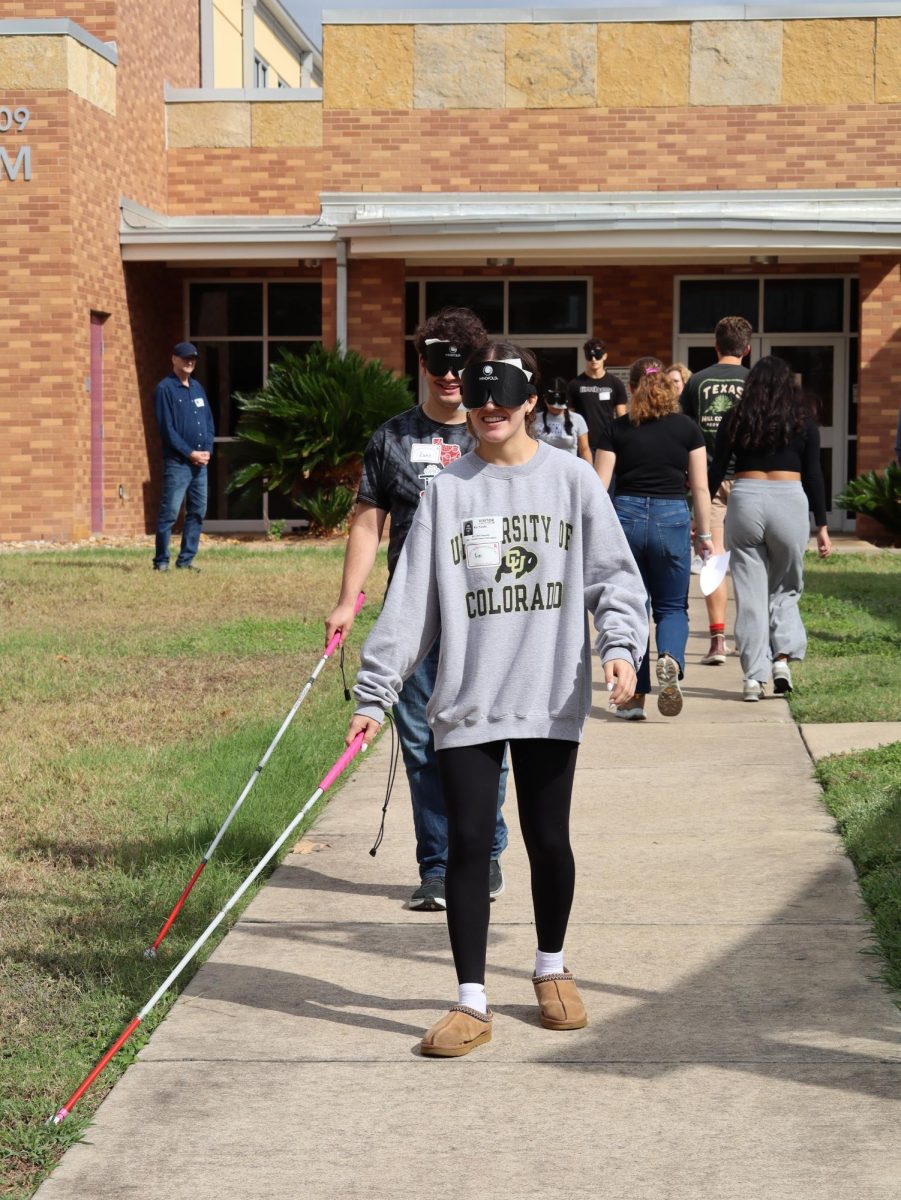
FINDING THE PATH: Senior Kai Talebi walks with her cane while blindfolded, following the path to reach the recreational building. While walking outside, the PALS utilized their canes to find the grass and make sure they stayed on the path. According to Talebi, despite it being difficult, walking with the cane gave her some new perspective on visual impairment.
“My favorite part of the cane station was feeling how disorienting it is to be without sight,” she said. “You begin to rely on your other senses, as well as leaning on other people around you, in this case, the instructors at TSBVI. Although it was nothing like being actually blind, it still gave me some interesting perspective.”
Along with many other PALS, this gave Talebi a new realization about how people with visual impairments lead regular lives.
“Learning from all the amazing people at TSBVI showed me the extent to which individuals with visual impairments can lead incredibly fulfilling and successful lives,” she said. “I left the visit feeling really impressed at all the amazing people I met.”
Talebi believes in the importance of being open to new experiences, and as a PAL making sure to take what they’ve learned and using it to become better mentors.
“A big part of PALS is having an open mind,” she said. “We value diversity so having these incredible experiences here we get to meet people who are different than us give us a really valuable perspective that we can then implement into our interactions as mentors with our kids and as members of our community.”
Along with walking with the cane, Talebi took a liking to many other parts of the experience.
“The day went super well,” she said. “Major highlights for me were getting to play goalball and getting blindfolded and guided around the campus. I also really loved the peanut butter and jelly station where we got to make our own sandwiches. It was overall an amazing experience that we were so lucky to be able to attend.”
Photo and caption by Wren Vanderford.
This story was originally published on The Shield Online on November 12, 2024.


